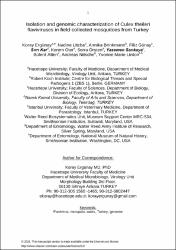| dc.contributor.author | Ergünay, Koray | |
| dc.contributor.author | Litzba, Nadine | |
| dc.contributor.author | Brinkmann, Annika | |
| dc.contributor.author | Gunay, Filiz | |
| dc.contributor.author | Kar, Sırrı | |
| dc.contributor.author | Öter, Kerem | |
| dc.contributor.author | Linton, Yvonne-Marie | |
| dc.date.accessioned | 2022-05-11T14:28:34Z | |
| dc.date.available | 2022-05-11T14:28:34Z | |
| dc.date.issued | 2016 | |
| dc.identifier.issn | 1567-1348 | |
| dc.identifier.issn | 1567-7257 | |
| dc.identifier.uri | https://doi.org/10.1016/j.meegid.2016.11.008 | |
| dc.identifier.uri | https://hdl.handle.net/20.500.11776/6873 | |
| dc.description.abstract | Vector surveillance for the arthropod-borne infections has resulted in the isolation of a growing number of novel viruses, including several flavivirus strains that exclusively replicate in insects. This report describes the isolation and genomic characterization of four insect-specific flaviviruses frommosquitoes, previously collected from various locations in Turkey. C6/36 Aedes albopictus and Vero cell lines were inoculated with mosquito pools. On C6/36 cells, mild cytopathic effects, characterized as rounding and detachment, were observed in four pools that comprised female Culex theileri mosquitoes. Complete (3 isolates, 10,697 nucleotides) or near-complete (1 isolate, 10,452 nucleotides) genomic characterization was performed in these culture supernatants via next generation sequencing. All strains demonstrated high genetic similarities, with over 99% identity match on nucleotide and amino acid alignments, revealing them to be different isolates of the same virus. Sequence comparisons identified the closest relative to be the Culex theileri flavivirus (CTFV) strains, originally characterized in Portugal. Phylogenetic analyses demonstrated that the isolates remained distinct as a cluster but formed amonophyletic group with CTFV strains, and shared a common ancestor with Quang Binh or related Culex flaviviruses. The organization of the viral genome was consistent with the universal flavivirus structure and stem-loops; conserved motifs and imperfect tandem repeats were identified in the non-coding ends of the viral genomes. A potential ribosomal shifting site, resulting in the translation of an additional reading frame, was detected. The deduced viral polyprotein comprised 3357 amino acids and was highly-conserved. Amino acid variations, presumably associated with adaptive environmental pressures, were identified. These isolates comprise the first fully characterized insect-specific flaviviruses in Turkey. Their impact on West Nile virus circulation, which is also endemic in the study region, remains to be explored. (C) 2016 Elsevier B.V. All rights reserved. | en_US |
| dc.description.sponsorship | Armed Forces Health Surveillance Center, Global Emerging Infections Surveillance and Response System (AFHSC-GEIS), United States [W81XWH-11-2-0174]; Georg Forster Research Fellowship (HERMES) for Experienced Researchers by Alexander von Humboldt Foundation; National Research Council (NRC) Research Associateship Award at the Walter Reed Army Institute of Research | en_US |
| dc.description.sponsorship | This study was partially supported by The Armed Forces Health Surveillance Center, Global Emerging Infections Surveillance and Response System (AFHSC-GEIS), United States (W81XWH-11-2-0174) (with Yvonne-Marie Linton as the principal investigator). KE is a recipient of the Georg Forster Research Fellowship (HERMES) for Experienced Researchers by the Alexander von Humboldt Foundation, 2015. This manuscript was prepared whilst YML held a National Research Council (NRC) Research Associateship Award at the Walter Reed Army Institute of Research. This research was performed in part under a Memorandum of Understanding between the Walter Reed Army Institute of Research and the Smithsonian Institution, with institutional support provided by both organizations. The funders had no role in study design, data collection and analysis, decision to publish or preparation of the manuscript. The material to be published reflects the views of the authors and should not be construed to represent those of the US Department of the Army or the US Department of Defense. | en_US |
| dc.language.iso | eng | en_US |
| dc.publisher | Elsevier | en_US |
| dc.identifier.doi | 10.1016/j.meegid.2016.11.008 | |
| dc.rights | info:eu-repo/semantics/openAccess | en_US |
| dc.subject | Flavivirus | en_US |
| dc.subject | Mosquito | en_US |
| dc.subject | Culex | en_US |
| dc.subject | Turkey | en_US |
| dc.subject | Genome | en_US |
| dc.subject | Genetic-Characterization | en_US |
| dc.subject | Alignment | en_US |
| dc.subject | Rna | en_US |
| dc.subject | Surveillance | en_US |
| dc.subject | Evolution | en_US |
| dc.subject | Viruses | en_US |
| dc.title | Isolation and genomic characterization of Culex theileri flaviviruses in field-collected mosquitoes from Turkey | en_US |
| dc.type | article | en_US |
| dc.relation.ispartof | Infection Genetics and Evolution | en_US |
| dc.department | Fakülteler, Fen Edebiyat Fakültesi, Biyoloji Bölümü | en_US |
| dc.authorid | 0000-0002-2583-6264 | |
| dc.authorid | 0000-0001-5422-1982 | |
| dc.authorid | 0000-0001-8185-3176 | |
| dc.authorid | 0000-0002-9711-4113 | |
| dc.identifier.volume | 46 | en_US |
| dc.identifier.startpage | 138 | en_US |
| dc.identifier.endpage | 147 | en_US |
| dc.institutionauthor | Kar, Sırrı | |
| dc.relation.publicationcategory | Makale - Uluslararası Hakemli Dergi - Kurum Öğretim Elemanı | en_US |
| dc.authorscopusid | 6507415764 | |
| dc.authorscopusid | 23566817100 | |
| dc.authorscopusid | 55258915300 | |
| dc.authorscopusid | 37114339500 | |
| dc.authorscopusid | 15769247000 | |
| dc.authorscopusid | 36968366100 | |
| dc.authorscopusid | 55881292900 | |
| dc.authorwosid | Gunay, Filiz/AAC-7874-2020 | |
| dc.authorwosid | Linton, Yvonne/AAG-2353-2019 | |
| dc.authorwosid | Ergunay, Koray/I-8368-2013 | |
| dc.authorwosid | Linton, Yvonne-Marie/AAW-3992-2021 | |
| dc.identifier.wos | WOS:000390456000021 | en_US |
| dc.identifier.scopus | 2-s2.0-84995576489 | en_US |
| dc.identifier.pmid | 27840255 | en_US |



















